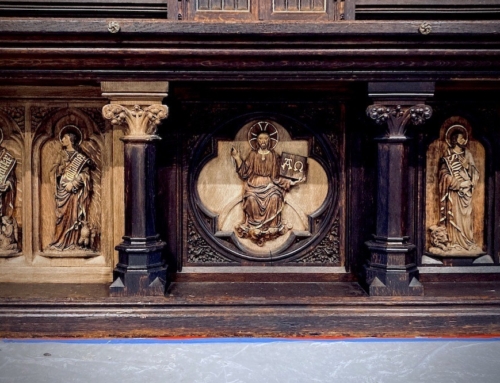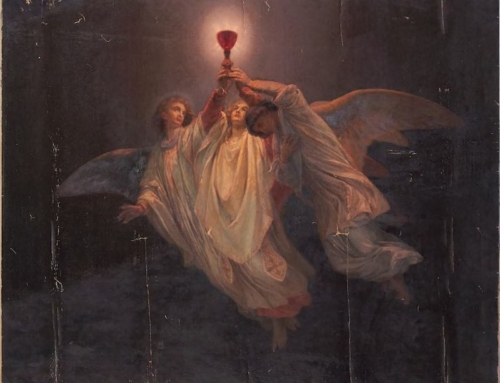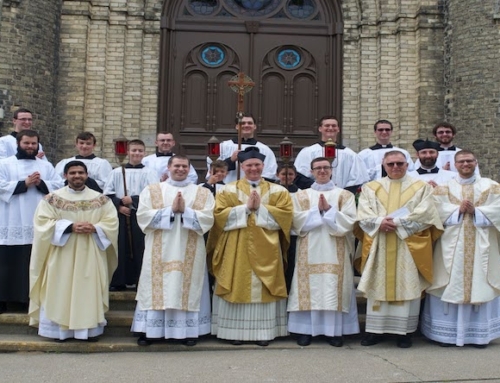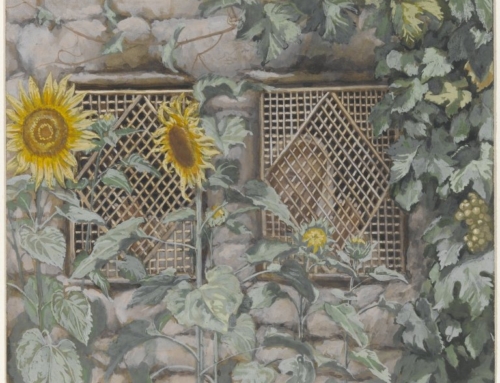We like new clothes. We don’t have to be shopaholics to appreciate what gives us a new look. We are especially reminded of this during the Advent and Christmas seasons, when shopping seems to be on everyone’s mind. Yet, perhaps to our surprise, there is a salvific significance about these things we pull off of shelves and hangers. In fact, clothing is explicitly mentioned at the beginning and end of Sacred Scripture. Reflecting on this may help us discover that there are better clothes to be worn than those we see in the department store.
It all began in the garden. When Adam and Eve ate the forbidden fruit they clothed themselves with fig leaves (Gen 3:7). Our first parents were not only stained with shame, but also with sin because of their offense against the Lord. Thus, they attempted to remedy their nakedness and sin by covering it up. Yet, God gave his own remedy with a new set of clothes made by himself rather than Adam and Eve (Gen 3:21). These animal skins foreshadow the clothes God will give to those he has redeemed from the stain of sin.
This redemption is found in Christ, who came to give us greater clothing: the clothing of those destined for glory. Jesus’ dazzling white robes in the Transfiguration prefigure this glorious apparel (Mt 17:2; Mk 9:3; Lk 9:29). Yet, Christ did not come just to give us shiny new clothes; he came to clothe us with himself. Saint Paul affirms this when he writes, “For all of you who were baptized into Christ have clothed yourselves with Christ” (Gal 3:27).
Saint Paul is telling us that we are clothed with Christ because in Baptism we ourselves have been washed in the blood that takes away the sins of the world. Christmas reminds us of this reality: Jesus came to save humanity, and he did so by “clothing” himself in human flesh—the flesh that was a source of our first parents’ sin and shame. He has redeemed this flesh of humanity by purifying it in the blood of the Lamb, his own flesh being “clothed” with blood on the Cross.
As Christ washes away our sins in his blood he ushers in the glory prefigured in the pure, white clothes of Mt. Tabor. Hence, as he is clothed in white, so are the elect at the end of Sacred Scripture: “They have washed their robes and made them white in the blood of the Lamb” (Rev 7:14). Although they have been redeemed, they are still clothed. The glory with which Christ clothes them is better than the nakedness of original justice, because they are clothed with Christ’s blood upon their garments. They are among those blessed “who wash their robes so as to have the right to the tree of life and enter the city through its gates” (Rev 22:14). The saints don these new clothes as they enter a new paradise where the new tree of life is found: the Cross of Christ.
Walking into this paradise far outweighs walking through the department store. The white garment we receive at our Baptism reminds us that we, as followers of Christ, are to prefer these new clothes to the ones offered by the world. We’re meant to wear something greater. Pope Emeritus Benedict XVI seems to agree when he speaks about the Transfiguration. He says, “Jesus’ garment of white light at the Transfiguration speaks of our future as well. Through Baptism [we] have been united with Jesus’ Passion, and his Passion is [our] purification” (Jesus of Nazareth: From the Baptism in the Jordan to the Transfiguration, 310).
As Dominicans, it’s easier for us to remember this because of our white habits! Still, all of the baptized need this kind of reminder. Perhaps the white host of the Eucharist and the Precious Blood can help us remember the purifying Passion of the Lamb. Whatever it takes, we ought to set aside the glamour of worldly clothing and put on the love of Christ who shed his blood for our salvation.
“And over all these put on love” (Col 3:14).
✠
Photo by Ethan Bodnar on Unsplash







